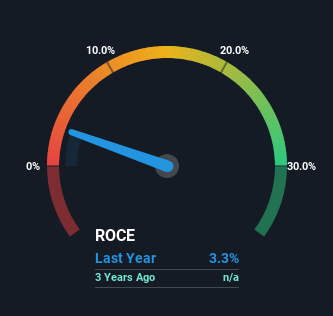- Croatia
- /
- Infrastructure
- /
- ZGSE:ULPL
ALPHA ADRIATIC d.d (ZGSE:ULPL) Has More To Do To Multiply In Value Going Forward
What are the early trends we should look for to identify a stock that could multiply in value over the long term? Ideally, a business will show two trends; firstly a growing return on capital employed (ROCE) and secondly, an increasing amount of capital employed. Ultimately, this demonstrates that it's a business that is reinvesting profits at increasing rates of return. Having said that, from a first glance at ALPHA ADRIATIC d.d (ZGSE:ULPL) we aren't jumping out of our chairs at how returns are trending, but let's have a deeper look.
What Is Return On Capital Employed (ROCE)?
For those who don't know, ROCE is a measure of a company's yearly pre-tax profit (its return), relative to the capital employed in the business. To calculate this metric for ALPHA ADRIATIC d.d, this is the formula:
Return on Capital Employed = Earnings Before Interest and Tax (EBIT) ÷ (Total Assets - Current Liabilities)
0.033 = €1.3m ÷ (€63m - €23m) (Based on the trailing twelve months to June 2023).
Thus, ALPHA ADRIATIC d.d has an ROCE of 3.3%. In absolute terms, that's a low return and it also under-performs the Infrastructure industry average of 8.5%.
Check out our latest analysis for ALPHA ADRIATIC d.d

Historical performance is a great place to start when researching a stock so above you can see the gauge for ALPHA ADRIATIC d.d's ROCE against it's prior returns. If you're interested in investigating ALPHA ADRIATIC d.d's past further, check out this free graph of past earnings, revenue and cash flow.
What The Trend Of ROCE Can Tell Us
We've noticed that although returns on capital are flat over the last five years, the amount of capital employed in the business has fallen 69% in that same period. When a company effectively decreases its assets base, it's not usually a sign to be optimistic on that company. In addition to that, since the ROCE doesn't scream "quality" at 3.3%, it's hard to get excited about these developments.
Another point to note, we noticed the company has increased current liabilities over the last five years. This is intriguing because if current liabilities hadn't increased to 38% of total assets, this reported ROCE would probably be less than3.3% because total capital employed would be higher.The 3.3% ROCE could be even lower if current liabilities weren't 38% of total assets, because the the formula would show a larger base of total capital employed. With that in mind, just be wary if this ratio increases in the future, because if it gets particularly high, this brings with it some new elements of risk.
The Key Takeaway
It's a shame to see that ALPHA ADRIATIC d.d is effectively shrinking in terms of its capital base. Since the stock has gained an impressive 41% over the last five years, investors must think there's better things to come. However, unless these underlying trends turn more positive, we wouldn't get our hopes up too high.
One more thing: We've identified 7 warning signs with ALPHA ADRIATIC d.d (at least 3 which shouldn't be ignored) , and understanding these would certainly be useful.
For those who like to invest in solid companies, check out this free list of companies with solid balance sheets and high returns on equity.
New: Manage All Your Stock Portfolios in One Place
We've created the ultimate portfolio companion for stock investors, and it's free.
• Connect an unlimited number of Portfolios and see your total in one currency
• Be alerted to new Warning Signs or Risks via email or mobile
• Track the Fair Value of your stocks
Have feedback on this article? Concerned about the content? Get in touch with us directly. Alternatively, email editorial-team (at) simplywallst.com.
This article by Simply Wall St is general in nature. We provide commentary based on historical data and analyst forecasts only using an unbiased methodology and our articles are not intended to be financial advice. It does not constitute a recommendation to buy or sell any stock, and does not take account of your objectives, or your financial situation. We aim to bring you long-term focused analysis driven by fundamental data. Note that our analysis may not factor in the latest price-sensitive company announcements or qualitative material. Simply Wall St has no position in any stocks mentioned.
About ZGSE:ULPL
Good value with slight risk.
Market Insights
Community Narratives


Recently Updated Narratives


Engineered for Stability. Positioned for Growth.


MINISO's fair value is projected at 26.69 with an anticipated PE ratio shift of 20x


Fiverr International will transform the freelance industry with AI-powered growth
Popular Narratives


MicroVision will explode future revenue by 380.37% with a vision towards success


NVDA: Expanding AI Demand Will Drive Major Data Center Investments Through 2026



